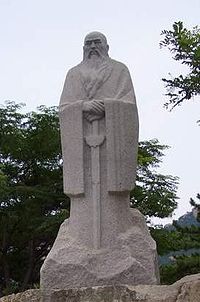The System of Lao Mountain
 |
| Lao Shan Mountain |
|
|
|
Lao Shan is a Mountain in Shandong province about 30km outside of Qingdao. It is unique in the contrast 1132.7m above the sea that laps at its base. It is famed as being the land of immortals. In Chinese history many have traveled to these mountains looking for the physical immortals. In the Qin Dynasty (BC 221-BC 206), the first emperor Qinshihuang make a pilgrimage to visit the immortals. In the Tang Dynasty ( AD 618 – AD 907), the great emperor Lee Longji to Laoshan to
find herbal medicines for eternal life. What he didn't realise is that the immortality training of Laoshan mountain is more what psychologists call "self actualization" and not physical immortality. For those well schooled in Taoism the nature of myth or reality was all subjective and only as true as it was useful. If the framework was not useful, then the construct was thrown a way. Zhuang Zi, a famous Taoist poet said that you use a fish to catch the trap, once the fish is caught then the trap is thrown away.
 |
| Restored Temple at Laoshan |
Laoshan Mountain area was home to one of the Quanzhen school of Taoism in history. At the height of its prosperity, there were 9
palaces, 8 temples, and 72 nunneries. These temples were destroyed durring the cultural revolution and very little of Lao Shan Pai remained in China. The Taoists from Laoshan Mountain
were well known for their religious knowledge, medical and martial arts skill and the land of the immortals which had served to train resistance troops in the Qing dynasty was seen as a primary target. Those educated and schooled in critical thinking were seen as a threat to the communists who were trying to brainwash the masses under a new state religion.
 |
| Statue of Wang Lang on Mount Lao |
Wang Lang had a foundation in Lao Shan Pai (Lao Mountain System) martial arts before he went to learn the 17 styles of Shaolin before eventually founding
Praying Mantis. He learned many of the medical and martial arts theories of the 17 styles and brough them back to Lao Shan. The first two generation inheritors of Praying Mantis kung fu were Yu zhou Dao Zhang and San Jian Dao Zhang. The title Dao Zhang means Daoist Master. The "Zhang" has the same meaning as "Zhang Men". This can be translated as Master Gate. He is the keeper of the system. Today we use the term "Grandmaster" because it is similar to the position of grandmaster in medieval guilds. The "Dao Zhang" was the master of several Taoist arts including medicine, feng shui and agriculture, music, religious duties,endocrine-psychology, martial arts, music and medicine. These disciplines were taught together as they all stem from Taoist scientific theory. Over time the varying aspects of this system became fragmented and scattered due to time, untimely death and persecution during the cultural revolution.
 |
| Worlds first Seismoscope was based the theory of the preheaven trigrams. |
 |
| First compass was based on the philosophical principles of polarity, eight trigrams and seven stars. |
|
|
 |
| The neuroendocrine system was symbolized by the Turtle, Dragon, Phoenix.and Tiger. |
The Taoist framework brought incredible breakthroughs in science such as the compass, the telescope and gunpowder. They created major feats of construction and an earthquake detection machine. With a firm root in the past and an open awareness for the future we have come to embrace the knowledge base and methodology of the scientific framework. Where the past holds grandmasters, the future of Lao Shan Pai is with academic deans, MRI machines, and lab tests. Modern firearm training and psychological research complement this ancient tradition which has continued to grow and evolve over time. From the stone age to the information age change remains one of the ruling principles of the universe and the study of change continues to fuel the growth and development of this ancient.tradition.
 |
| Laoshan Taoist Music may have been preserved in China |
 |
| Modern monks learn in religious colleges and are paid government workers. |
 |
ACMAF Testing committee reviewing applicants in 1999
|
|
 |
| Daniel Finlay continues the tradition as a doctor specializing in headaches. |
|
|
|
|
 |
| Andrew Miles also practices Chinese Medicine focusing on Andrology and endocrine disorders. |
|
|
 |
| Master Peter Ray M.D. specializes in Surgery and coined the term "Abimoxi" to describe Lao Shan Medicine. |
 |
| As a clinical pharmacist Master Cimino has been instrumental in publishing books on Lao Shan Pai. |















No comments:
Post a Comment